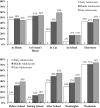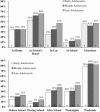Where and when adolescents use tobacco, alcohol, and marijuana: comparisons by age, gender, and race
- PMID: 23384377
- PMCID: PMC3568168
- DOI: 10.15288/jsad.2013.74.288
Where and when adolescents use tobacco, alcohol, and marijuana: comparisons by age, gender, and race
Abstract
Objective: This study examined the location and time of adolescent use of cigarettes, alcohol, and marijuana. Age, gender, and racial differences in location and time of use were studied for each substance.
Method: Using cross-sectional data collected through the schoolwide Pride Survey, 20,055 students between the ages of 10 and 19 years (53.6% female, 55.1% Black, 44.9% White) in one metropolitan area reported on their frequency of cigarette, alcohol, and marijuana use, as well as the location and time of use of each substance. Chi-square tests compared the rates, locations, and times for each substance across boys and girls; Black and White students; and early, middle, and late adolescents.
Results: Older adolescents reported higher rates of substance use at friends' homes, at school, and in cars and lower rates of alcohol use at home compared with younger youth. Males were more likely to report alcohol and marijuana use at school and on weeknights and alcohol use in cars, whereas females were more likely to report alcohol and marijuana use on the weekends. No gender differences emerged for times and locations of cigarette use. Compared with Black youth, White adolescents were more likely to use all substances at friends' homes and on weekends; to smoke cigarettes at school, in the car, and on weeknights; and to use alcohol at home. Black adolescents were more likely to report using alcohol at home, at school, in cars, during and after school, and on weeknights and were more likely to report using marijuana at school.
Conclusions: The location and time of adolescent substance use vary substantially by age, gender, and race. These differences may help tailor substance use prevention and intervention programs to specific subgroups of youth to improve program effectiveness.
Figures



Similar articles
-
School-Level Correlates of Adolescent Tobacco, Alcohol, and Marijuana Use.Subst Use Misuse. 2015;50(12):1518-28. doi: 10.3109/10826084.2015.1023449. Epub 2015 Nov 19. Subst Use Misuse. 2015. PMID: 26584423 Free PMC article.
-
Racial/ethnic differences in use of alcohol, tobacco, and marijuana: is there a cross-over from adolescence to adulthood?Soc Sci Med. 2015 Jan;124:132-41. doi: 10.1016/j.socscimed.2014.11.035. Epub 2014 Nov 18. Soc Sci Med. 2015. PMID: 25461870 Free PMC article.
-
Not Just Cigarettes: A More Comprehensive Look at Marijuana and Tobacco Use Among African American and White Youth and Young Adults.Nicotine Tob Res. 2016 Apr;18 Suppl 1(Suppl 1):S65-72. doi: 10.1093/ntr/ntv202. Nicotine Tob Res. 2016. PMID: 26980865 Free PMC article.
-
Social Inequality and Substance Use and Problematic Gambling Among Adolescents and Young Adults: A Review of Epidemiological Surveys in Germany.Curr Drug Abuse Rev. 2016;9(1):26-48. doi: 10.2174/1874473709666151209114023. Curr Drug Abuse Rev. 2016. PMID: 26647784 Review.
-
Alcohol use in multiracial American youth compared with monoracial youth: A meta-analysis.Addiction. 2024 Jan;119(1):47-59. doi: 10.1111/add.16310. Epub 2023 Aug 10. Addiction. 2024. PMID: 37563711 Free PMC article. Review.
Cited by
-
Selection and Socialization Influences on Adolescent Alcohol Use: The Individual and Joint Contexts of Neighborhood Disadvantage and Population Density.Subst Use Misuse. 2019;54(10):1663-1678. doi: 10.1080/10826084.2019.1608247. Epub 2019 May 3. Subst Use Misuse. 2019. PMID: 31046537 Free PMC article.
-
Up in Smoke: Neighborhood Contexts of Marijuana Use from Adolescence Through Young Adulthood.J Youth Adolesc. 2016 Jan;45(1):35-53. doi: 10.1007/s10964-015-0370-5. J Youth Adolesc. 2016. PMID: 26496730
-
Who's Got the Booze? The Role of Access to Alcohol in the Relations Between Social Status and Individual Use.J Stud Alcohol Drugs. 2017 Sep;78(5):754-762. doi: 10.15288/jsad.2017.78.754. J Stud Alcohol Drugs. 2017. PMID: 28930063 Free PMC article.
-
Prevalence of E-Cigarette Use and Its Associated Factors Among Youths Aged 12 to 16 Years in 68 Countries and Territories: Global Youth Tobacco Survey, 2012‒2019.Am J Public Health. 2022 Apr;112(4):650-661. doi: 10.2105/AJPH.2021.306686. Am J Public Health. 2022. PMID: 35319939 Free PMC article.
-
Youth Demographic Characteristics and Risk Perception of Using Alternative Tobacco Products: An Analysis of the 2014-2015 Canadian Student Tobacco, Alcohol, and Drugs Survey (CSTADS).Tob Use Insights. 2021 Nov 22;14:1179173X211058150. doi: 10.1177/1179173X211058150. eCollection 2021. Tob Use Insights. 2021. PMID: 34866954 Free PMC article.
References
-
- Brown SA, Vik PW, Creamer VA. Characteristics of relapse following adolescent substance abuse treatment. Addictive Behaviors. 1989;14:291–300. - PubMed
-
- Casswell S, Stewart J, Connolly G, Silva P. A longitudinal study of New Zealand children’s experience with alcohol. British Journal of Addiction. 1991;86:277–285. - PubMed
Publication types
MeSH terms
Grants and funding
LinkOut - more resources
Full Text Sources
Medical

